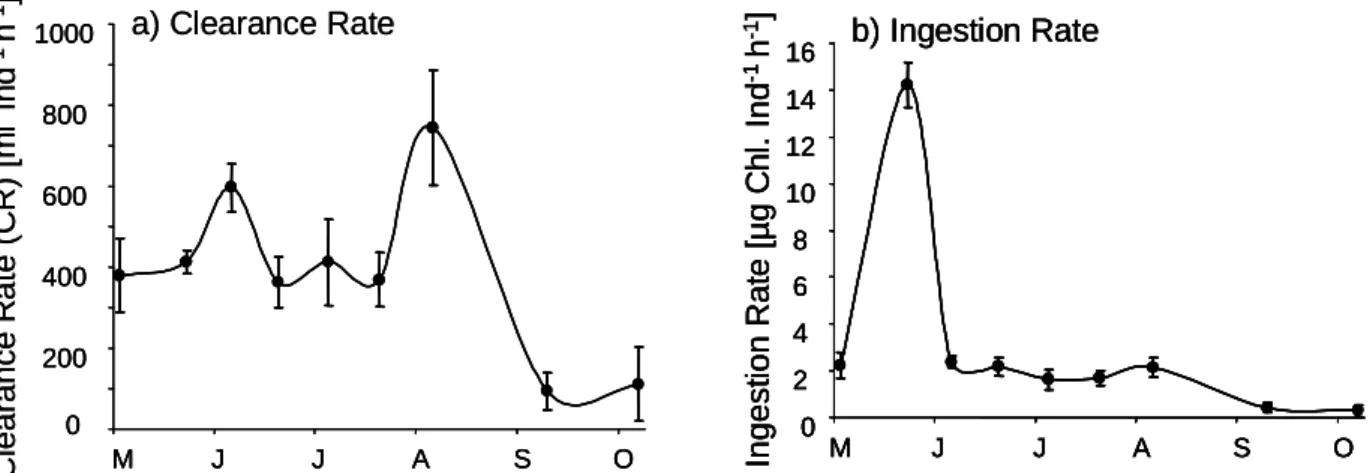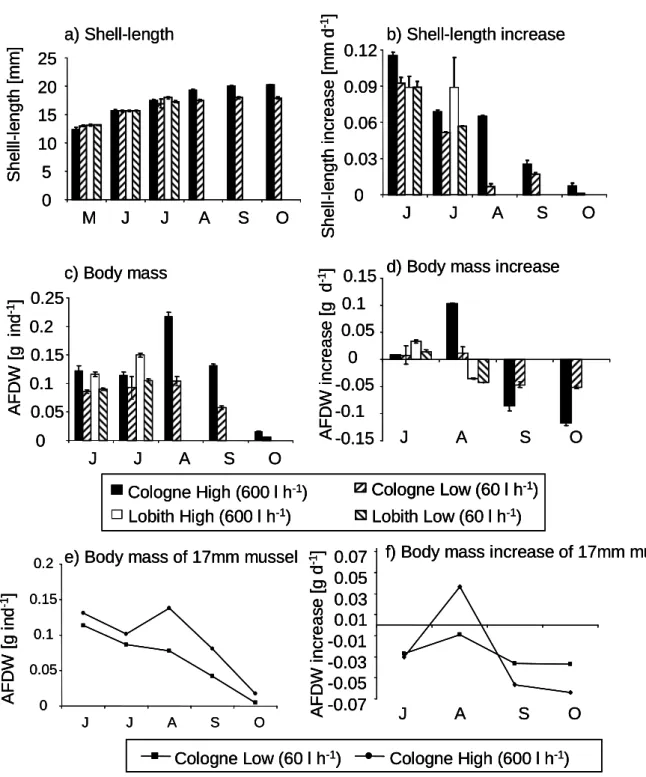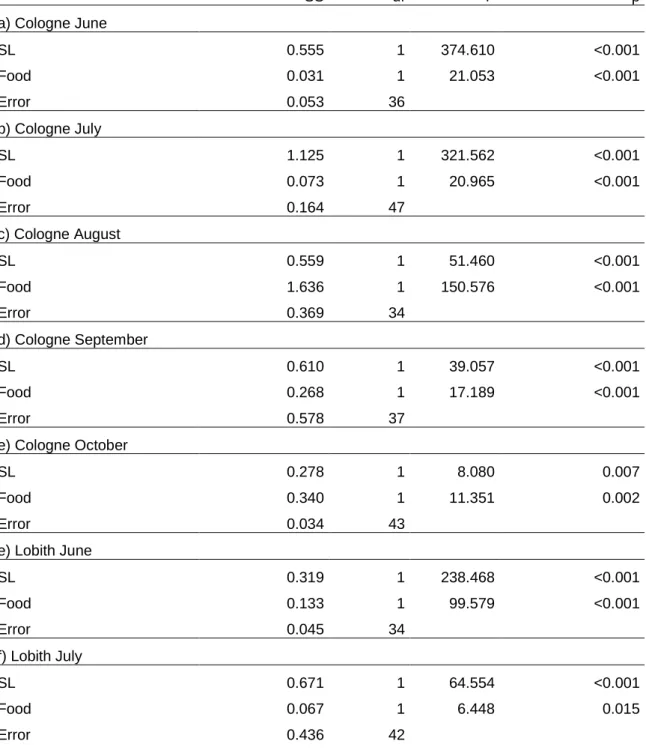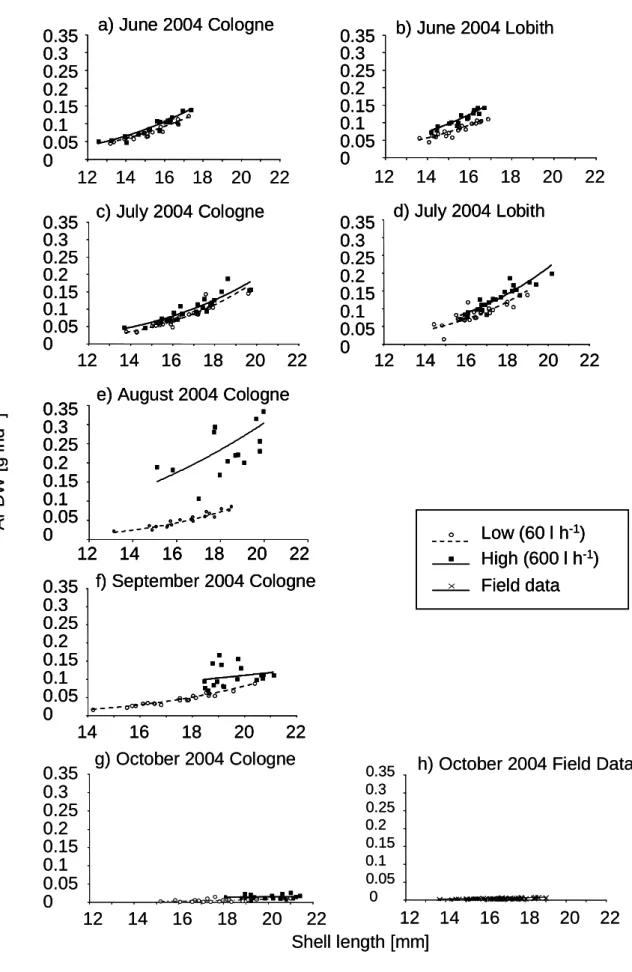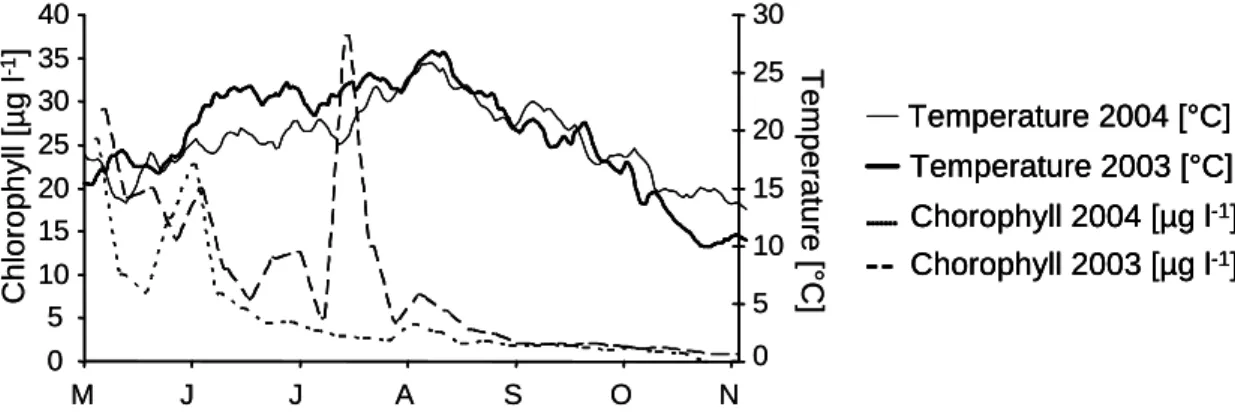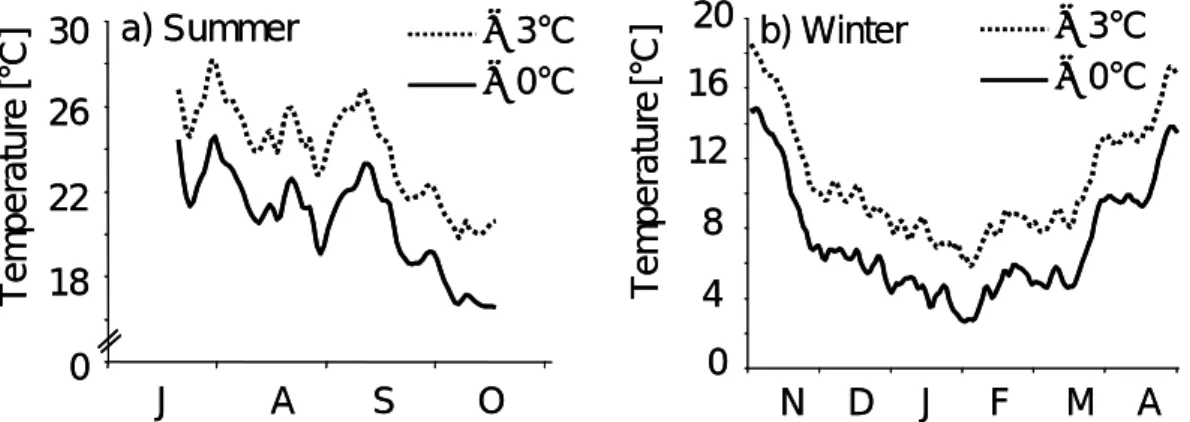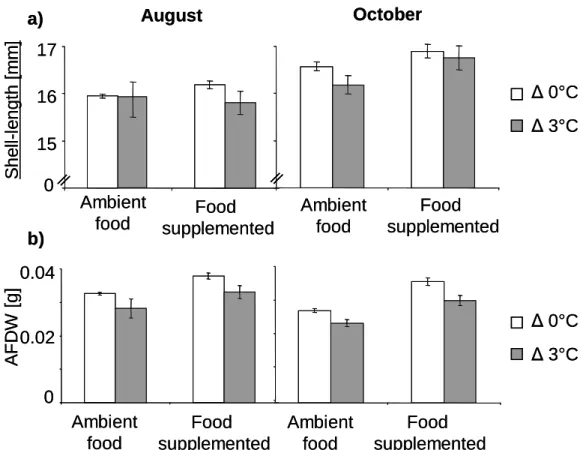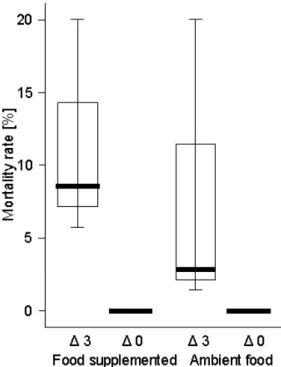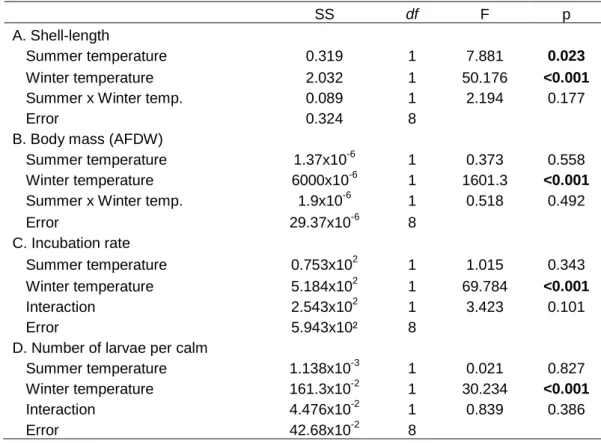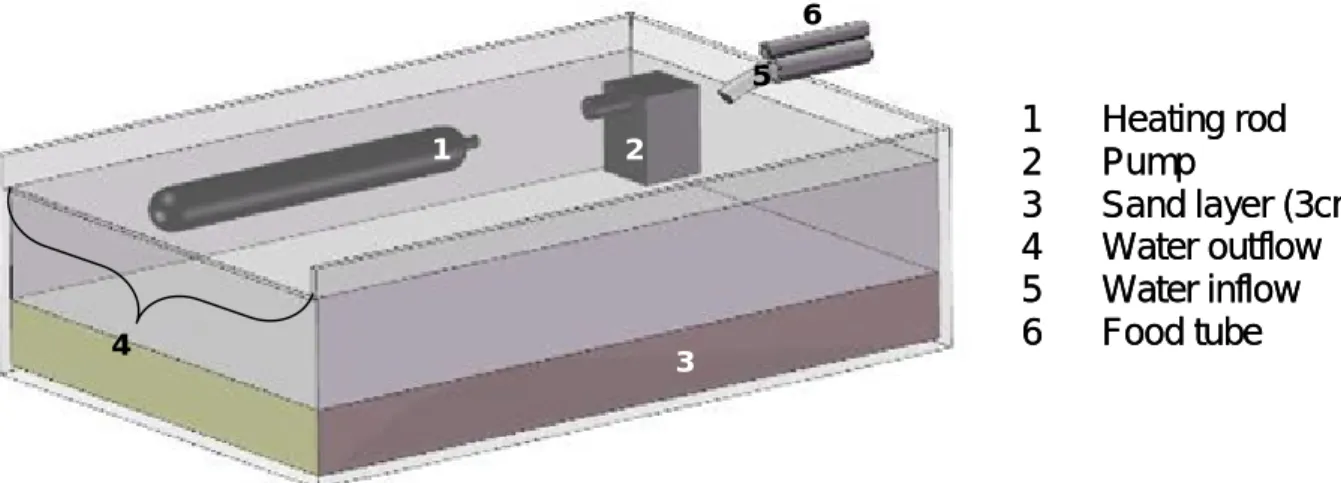and feeding activity of riverine benthic filter feeders
Inaugural-Dissertation
zur
Erlangung des Doktorgrades
der Mathematisch–Naturwissenschaftlichen Fakultät der Universität zu Köln
vorgelegt von
Andreas Vohmann aus Mönchengladbach
Hundt Druck GmbH, Köln
2008
Prof. Dr. Hartmut Arndt Prof. Dr. Michael Bonkowski
Tag der letzten mündlichen Prüfung:
21. Oktober 2008
Danksagung:
Ich möchte mich bei Prof. Dr. Hartmut Arndt ganz herzlich für die Möglichkeit bedanken, meine Arbeit in seiner Arbeitsgruppe anzufertigen.
Herrn Prof. Dr. Michael Bonkowski danke ich recht herzlich für die Bereitschaft zur Begutachtung meiner Arbeit.
Mein ganz besonderer Dank gilt Herrn Dr. Markus Weitere für die Betreuung und die Unterstützung bei meiner Arbeit sowie dafür, dass er mir die Finanzierung ermöglicht hat. Mein Dank richtet sich in diesem Zusammenhang auch an die deutsche Forschungsgesellschaft (DFG) für die Finanzierung meiner Arbeit im Rahmen des Schwerpunkprogramms AQUASHIFT.
Ich danke Marcel Kathol, Nadine Schulz und Carsten Viergutz für ihre Unterstützung bei den mikroskopischen Auszählungsarbeiten.
Catherine Linn danke ich für die gute Zusammenarbeit hinsichtlich der Experimente mit Corbicula fluminea im Sommer 2007 sowie Dr. Desirée Dietrich für ihre Hilfe bei den Messungen und der Pflege der Versuchsanlage.
Bei Sascha Roterberg möchte ich mich für graphische Darstellung der Versuchsanlage in Kapitel 3 bedanken.
Ich danke der Besatzung der ökologischen Rheinstation für die allzeit angenehme Atmosphäre, vor allem Dr. Helge Norf, Marcel Kathol und Carsten Viergutz die immer Gesprächspartner für die alltäglichen Themen waren.
Ebenso danke ich den Mitarbeiterinnen und Mitarbeitern der ganzen Arbeitsgruppe, besonders Bärbel Jendral, Rosita Bieg, Brigitte Gräfe, Jörg Schramm und Bruno Zündorf für die erfolgreiche Zusammenarbeit der letzten Jahre.
Ich danke Frederic Bartlett für seine hilfreichen Kommentare und die sprachliche Korrektur.
Ich danke meinen Eltern und meinen Brüdern für ihren Zuspruch und ihre
Unterstützung während meiner Arbeit sowie meiner lieben Freundin Birgit, die
mir während des Studiums und der Promotion immer zur Seite stand.
Table of Contents
General Introduction 5
Chapter 1
Strong body mass decrease of the invasive clam Corbicula fluminea during summer
11
Chapter 2
The impact of summer versus winter warming on the fitness of the invasive clam Corbicula fluminea
30
Chapter 3
The impact of temperature increase and food quantity on the body mass, growth and respiration of Corbicula fluminea
48
Chapter 4
Grazing impact and phenology of the freshwater sponge Ephydatia muelleri and the bryozoans Plumatella emarginata and Fredericella sultana under experimental warming
69
General Conclusions 96
References 100
Zusammenfassung 112
Kurzzusammenfassung 122
Abtract 124
Erklärung 126
Teilpublikationen 127
Curriculum Vitae 128
General Introduction
The grazing of benthic filter feeders on planktonic organisms is an important interaction in freshwater ecosystems in that it has consequences on ecosystem function by controlling the plankton communities and affecting plankton composition. It can have ecosystem-wide consequences by influencing the water transparency and therewith the growth of macrophytes. Furthermore, benthic filter feeders import the planktonic primary and secondary production into the benthic food web. (Welker & Walz, 1998; Strayer et al., 1999; Jack &
Thorp, 2000; Weitere & Arndt 2002; Ricciardi, 2003).
The benthic grazer community is diverse. Filter-feeding insect larvae, biofilm communities, sponges, bryozoans and mussels can be abundant in freshwater ecosystems. Their composition depends on the ecosystem and the prevalent conditions. Community composition, function and activity is very sensitive towards changes of the environmental factors. Temperature is one such important factor in that it influences the filtration activity of benthic filter feeders (Walz, 1987; Aldridge et al., 1995; Lei et al., 1996); the growth of planktonic organisms is also mainly controlled by temperature (Montagnes et al., 2003). A change in the temperature regime might thus lead to pronounced changes in plankton communities due to the differential development of grazing and growth with warming (cf. Viergutz et al., 2007; Weitere et al., 2008).
We are currently facing a global climate change due to the emission of greenhouse gases (IPCC, 2007). For central Europe, the strongest seasonal temperature increase is predicted for winter (IPCC, 2007), while the summers will probably experience irregularly occurring heat waves with increasing frequencies (Schär et al., 2004; Stott et al., 2004). An increase in the average global temperature of 0.7°C already occurred in the second half of the 19
thcentury. Suppositions regarding the temperature increase scenarios for the 21
stcentury are based on the assumption of an average global temperature increase of between 1.7°C and 4°C (IPCC, 2007).
Temperature has the a very strong influence on the metabolic rates of
organisms (Gillooly et al., 2002; Savage et al., 2004). An increase in
temperature, up to a certain limit, has consequences on the food uptake, and in
the case of benthic consumers, leads to an increase in the grazing pressure on
the plankton. Other possible responses of temperature changes may include
changes in the timing of seasonal activities (Both & Visser 2001; Menzel et al., 2001) which may result in an unparallel shift of interspecific interactions between grazers and the plankton communities. In addition, warming can affect the fitness of the organisms. In this context it is important to understand the impact of temperature on benthic filter feeders to be able to draw conclusions regarding the consequences of increasing temperatures to aquatic ecosystem.
For such studies it is logical to choose organisms which have been investigated well on the one hand and are important for the respective ecosystem on the other hand.
Mussels are efficient filter feeders and belong to the abundant grazers in many freshwater ecosystems, such as the River Rhine, the study site of the present work (Meister, 1997; Rajagopal et al., 2000). The River Rhine is the largest river in central Europe and one of its most important waterways (Tittzer & Krebs, 1996). The canalization and the industrial use of rivers in the last century has caused drastic changes in the ecosystem structure and has resulted in consequences such as the destruction of natural habitats, higher flow velocities, organic and inorganic pollution as well as pollution in terms of heat emissions.
Especially the pollution with industrial chemicals has affected the ecosystem in the second half of the last century and has considerably depleted the native fauna of the river (Ortmann, 2003).
In the last decades, a continuous improvement in water quality has stimulated faunal recovery. But the debilitated fauna has become sensitive towards invasion. The freshwater clam Corbicula fluminea, native to Southeast Asia, has successfully invaded freshwater habitats in Europe, Africa, North and South America and the Pacific islands (Phelps, 1994; Darrigran, 2002; Karatayev et al., 2005). The Rhine was invaded by Corbicula fluminea in the 1980s, probably by man-made vectors such as the ballast water of ships (Bij de Vaate &
Greijdanus-Klaas, 1990; Bij de Vaate, 1991; Karatayev, 2007). Its ability to tolerate a wide range of environmental conditions, its high fecundity, brood care and young age of maturity are considered to be reasons for the successful spreading of Corbicula fluminea. Today, it is the most common mussel in the River Rhine (Rajagopal et al. 2000; McMahon 2002; Karatayev et al., 2003).
Impacts on filter-feeding clams include strong decreases in phyto- and
zooplankton abundances, nutrient releases and increases in bacterial
abundances (Kryger & Riisgard, 1988; Strayer et al., 1999; Vaughn &
Hakenkamp, 2001).
Corbicula fluminea has been well studied over the last decades, and some of these studies focussed on the impact that temperature has on the mussels’
feeding behaviour (Viergutz et al., 2007). These authors found an increase in feeding rate with temperature increases of up to 25°C, but decreasing feeding rates above this temperature. We know from other studies on freshwater mussels that warm temperatures result in an increase of the metabolic rate, whereas the feeding rate cannot cope with the demand (Aldridge et al., 1995;
Lei et al., 1996) which may alter the fitness of the mussels (Ortmann &
Grieshaber, 2003).
The present study was stimulated by the observation that Corbicula fluminea can experience mass mortalities affecting all size classes during warm summers (for the Rhine see: Westermann & Wendling, 2003; Demuth et al., 2004; Kroner et al., 2004; own observations, for other rivers see: Cooper et al., 2005). Other mussels such as Dreissena polymorpha and Corbicula fluminalis as well as other species of macrozoobenthos did not show a corresponding mortality in the River Rhine. Temperature as the only reason for the mass mortality was ruled out, since Corbicula fluminea originates from warmer areas and tolerates temperatures of up to 37°C (Mattice & Dye, 1976). We wanted to find out whether or not high energetic costs at high temperatures and simultaneous low plankton concentrations in the River Rhine during summer (Weitere et al., 2005) lead to a negative energetic balance of Corbicula fluminea. In winter, an increase in temperature seems to have the opposite impact on Corbicula fluminea; this observation was supported by the finding that an exposure to temperatures of between 1°C and 2°C correlates with increased mortality (Mattice & Dye, 1976; Rodgers et al., 1977; Morgan et al., 2003).
These findings led to the hypothesis that summer versus winter warming results in contrasting effects on fitness parameters of Corbicula fluminea.
As mentioned above, mussels were often chosen as model organisms for
analysing the impact of benthic filter feeders and their responses to changing
environmental conditions. However, mussels are only one (albeit important)
representative of the benthic filter-feeder community (Monakov, 2003). Another
aim of the present study was to introduce two new species into the debate on
the influence of warming on benthic filter feeders. The focus was to determine whether or not the results found for Corbicula fluminea can be applied to other groups of filter feeders to form the basis of prediction models for forecasting the consequences of global change. Sponges and bryozoans are widely distributed, common filter feeders (Okamura & Doolan, 1993; De Santo & Fell, 1996; Pile et al., 1997) which have often been overlooked when analysing the filtration impact of benthic grazers, so there are relatively few studies available on the grazing behaviour of these two freshwater taxa. We used Epydatia muelleri and Plumatella emarginata as common representatives of freshwater sponges and bryozoans respectively (Ricciardi & Reiswig, 1994; Økland & Økland, 1996;
Wood et al., 1998; Gugel, 2000; Økland & Økland, 2001; Fesl et al., 2005;
Dröscher & Waringer, 2007), and analysed their grazing rates under experimental warming to determine in what way temperature increase affects their feeding.
Both taxa form resting stages and spend the winter months in diapauses (Pronzato et al., 1993; Wood & Okamura, 2005); both are seasonal activities which may be sensitive to temperature changes (Black & Proud, 1976;
Weissenfels, 1989; Gugel, 2000). We observed the phasing out of trophic stages in the fall and the winter months until the germination of the sponge Ephydatia muelleri and the bryozoans Plumatella emarginata and Fredericella sultana in spring under experimental warming by 3°C above the ambient Rhine temperature. The hypothesis was that temperature affects the timing of these seasonal activities, resulting in a later phasing out in autumn or/and an earlier germination in spring.
Chapter 1 deals with the hypothesis that the food quantity (under natural
conditions) affects the body mass and the shell length increase of Corbicula
fluminea during summer. The mussels were kept in glass tanks which were
filled with a 3 cm sand and were connected to a river bypass. In one
experiment, the food concentration was manipulated by using different flow
velocities of the fresh Rhine water. The hypothesis of a negative energetic
balance of Corbicula fluminea in summer due to high energetic costs and low
plankton concentrations was tested by measuring the body mass and the shell
length increase.
Chapter 2 focussed on the contrasting effects of summer versus winter warming, which included experimental temperature elevations. In a summer experiment, the temperature was elevated to 3°C above ambient Rhine temperature, and a food supplementation was achieved by using an additional food source. This experiment was designed to reveal the influence of food and temperature levels on Corbicula fluminea.
In a winter experiment, the mussels from the summer with their different summer temperature histories were used and divided crosswise into ambient and warmed temperature treatments. For both experiments the body mass as well as the shell length development was analysed as a measure of the fitness, and the fecundity at the end of the experiment in spring 2006 was detected by analysing the incubation rate (number of mussels with incubated larvae as a percentage of all mussels) and the absolute number of larvae. The influence of winter warming and the role of the temperature history of the previous summer on the fitness and fecundity of Corbicula fluminea in spring was considered when planning this experiment.
Chapter 3: The results of the earlier experiments on Corbicula fluminea (chapters 1, 2) revealed contrasting effects of temperature between summer and winter. Summer warming resulted in a decrease of the body mass and an increase of the mortality rate, whereas winter warming led to a body mass increase and a positive impact on fecundity in spring. The experiment described in chapter 3 was arranged to (i) detect the time at which the temperature impact on Corbicula fluminea became negative towards the summer and (ii) to better understand the connection between the roles of temperature and food quantity.
We thus lengthened the experimental period and started the experiment in April
2007, just at that time of year when the winter experiment described in chapter
2 was terminated and the positive impact of temperature was still present. A
high frequency of shell length measurements gave a detailed picture of growth
of Corbicula fluminea during summer. Five measurements of body mass during
summer revealed the development of body mass between April and October
and enabled the determination of periods with increasing and decreasing body
mass values. The analysis of respiration rates enabled the interpretation of the
fitness data sampled by this study in comparison to the results on feeding rate reassessments of Corbicula fluminea reported by Viergutz et al. (2007).
In order to see if the mussels’ response to warming is representative for all filter feeders, other benthic filter feeders of which little is known regarding their interactions with plankton communities as well as their response to temperature changes were studied and the results given in chapter 4. Suitable set ups were required to permit the study the sponge Ephydatia muelleri and the bryozoan Plumatella emarginata. Compared to mussels, it is more difficult to divide these taxa into defined units. Furthermore, the determination of the species is only possible by taking the resting stages into account. Different types of flow cells were chosen to measure clearance rates of the bryozoan and the sponge.
Feeding rates were determined by connecting the flow cells to the river bypass
and exposing them in temperature-controlled water tanks. Measurements of the
food concentration from the inflow and the outflow formed the bases for the
calculation of clearance rates. The timing of phonology events (e.g. forming of
resting stages in autumn and re-colonisation in spring) was analysed with help
of winter experiments in bypass systems under temperature manipulation by
3°C above the ambient river temperature.
Chapter 1
Strong body mass decrease of the invasive clam
Corbicula fluminea during summer
Abstract
The filter-feeding clam Corbicula fluminea has widely spread from its Asiatic origin into freshwater habitats on several continents, where it often has a considerable impact on ecosystem processes. The present study was stimulated by the observation that Corbicula fluminea can experience mass mortality during warm summers, even when temperatures are still far below the lethal level. We hypothesised that starvation due to low food quantities during summer is a main factor in this context. In order to test nutritional conditions in an environment where summer mortality occurred, the clams´ body mass was tracked in river bypass systems installed at the Lower River Rhine (Germany and The Netherlands). Two food levels were adjusted in the bypass channels:
one corresponding to the original chlorophyll level in the river (ambient food) and one with a chlorophyll a level reduced by about 50% (low food). The clams kept at the ambient food level increased their shell length during summer, although growth rates decreased at low food levels in the River Rhine in late summer. In comparison to shell length, body mass decrease in late summer cumulated in 94% reduction from August until October. This trend was enhanced by the experimental food reduction, i.e. clams kept in the low food level treatments weighed 60% less than the clams in the ambient food treatment at the end of summer. However, mortality was low in both treatments.
The data demonstrate a high plasticity in the body mass of Corbicula fluminea, which helps to survive during starvation periods. Nevertheless, the extremely low body masses at the end of summer also suggest that further increases in the starvation stress in years with lower phytoplankton biomasses or higher energetic demands at high temperatures could lead to mass mortality events.
Introduction
The bivalve Corbicula fluminea, native to Southeast Asia, has successfully
invaded freshwater habitats in Europe, Africa, North and South America and the
Pacific islands (Phelps, 1994; Darrigran, 2002; Karatayev et al., 2005). The
River Rhine in central Europe, the study area of the present investigation, was
invaded by Corbicula fluminea in the 1980s, probably via ballast water (Bij de
Vaate & Greijdanus-Klaas 1990; Bij de Vaate, 1991; Karatayev, 2007).
Properties such as the ability to tolerate a wide range of environmental conditions, a high fecundity, brood care and a young maturity age are considered to be important reasons for the successful spread of the species (Rajagopal et al., 2000; McMahon, 2002; Karatayev et al., 2003).
Once local populations are established, Corbicula fluminea can attain high densities (Cataldo & Boltovskoy, 1998; Schöll, 2000; Morgan et al., 2003).
Dense populations of filter-feeding clams can have a considerable impact on the structure of planktonic communities and correspondingly on ecosystem processes (Strayer et al. 1999; Ricciardi 2003). Impacts include strong decreases in phyto- and zooplankton abundances, nutrient releases and increases in bacterial abundances (Kryger & Riisgard, 1988; Strayer et al., 1999; Vaughn & Hakenkamp, 2001). For Corbicula fluminea in particular, considerable decreases in the phytoplankton densities have been observed in response to its invasion, resulting in secondary and tertiary effects, e.g.
increase of water transparency, followed by the establishment of macrophytes (Cohen et al., 1984; Phelps, 1994; Caraco et al., 2006).
Given the wide distribution of Corbicula fluminea as well as its potentially strong impact on ecosystem processes, there is great interest in factors which hinder the spread of the clam. In the past years, a high mortality of Corbicula fluminea has occurred in the summer months in the River Rhine affecting all size classes (Westermann & Wendling, 2003; own observations). Such rapids die-offs under conditions of warm summer temperatures were also observed in other rivers (Cooper et al., 2005). Other mussels such as Dreissena polymorpha and C.
fluminalis as well as other species of macrozoobenthos did not show a corresponding mortality in the River Rhine. Reasons for the mass mortality in Corbicula fluminea are unknown. High water temperature alone does not seem to be a plausible explanation for this phenomenon; the clam originates from much warmer areas and can tolerate temperatures of up to 37°C (Mattice &
Dye, 1976; McMahon & Williams, 1986), while maximum temperature in the Rhine did not exceed 28°C (http://www.lanuv.nrw.de/aktuelles/umwdat.htm).
Lack of oxygen could be excluded as a reason for mortality (Johnson &
McMahon, 1998), as oxygen concentrations at the time when most clams died
were sufficiently high with values of 6-7 mg l
-1(Ortmann & Grieshaber, 2003;
Westermann & Wendling, 2003).
Another reason for stress in the clams, which might cumulate in mortality, is low food quantity during summer. A positive correlation between chlorophyll a concentration and the growth rate of Corbicula fluminea was demonstrated in field studies (Cohen et al., 1984; Foe & Knight, 1985). In contrast to native inhabitants of the northern hemisphere, Corbicula fluminea is characterized by high growth rates and fecundity for rapid population recovery; the disadvantages for the species are high metabolic rates and correspondingly high food demands (McMahon, 2002). According to Foe & Knight (1985), food limitation for Corbicula fluminea occurs at a chlorophyll a concentration of below 20 µg l
-1in spring and below 47.3 µg l
-1in summer.
In the River Rhine, algae abundance decreased strongly after a spring peak, as expressed by low chlorophyll a concentrations below 10 µg l
-1in late summer (Weitere et al., 2005, see also Fig. 1). This low food level coincided with a high temperature and a correspondingly high energy demand of the clams (McMahon, 2002; Ortmann & Grieshaber, 2003). Mouthon (2001) reported similarly low chlorophyll concentrations in the Saone River (France) between 1987 and 1999. The author found clear indications for starvation in Corbicula fluminea such as reduced growth and only a single instead of two annual reproductive periods.
The present case study for the Rhine is thus based on the hypothesis that Corbicula fluminea faces longer starvation periods during the summer, leading to stress as expressed by body mass decrease and mortality. To test this hypothesis, we constructed river bypass systems to study growth, condition and survival of Corbicula fluminea under both in situ and reduced food levels. The experimental systems were run at two stations situated in the lower Rhine.
Material and Methods
Study sites and general experimental set-up
In order to test the impact of food availability on growth and survival of
Corbicula fluminea under natural conditions, we performed two experiments in a
river bypass system. A similar bypass system had been used to test the effect of food limitation and food competition on filter feeding mayfly larvae at the Ecological Rhine Station of the University of Cologne (Kureck & Bieg, 2001), where the main experiment of this study was conducted. The laboratories of the station are located on a boat anchored in the vicinity of Cologne-Marienburg (Germany, Rhine-km 684.5, which refers to the distance from Lake Constance, the source of the non-alpine Rhine). This experiment lasted the entire summer;
it was started on May 12, 2004 and terminated on October 13, 2004. A second experiment with the same set-up was run in the lower Rhine in a floating measuring station of the Institute for Inland Water Management and Waste Water Treatment (RIZA) in Lobith (The Netherlands, Rhine-km 863.0). This experiment started on May 19, 2004 and terminated on July 31, 2004 after it was confirmed that the same trends were observed as in the main experiment in Cologne. Both stations were permanently supplied with fresh Rhine water.
Flat glass tanks (49.5cm x 35.5cm x 10cm) were used in the experiments as river bypass systems. Two different food conditions were established at both locations by adjusting different flow rates of Rhine water. In one treatment, a rate of 600 l h
-1(high flow rate) was used; this flow rate is high enough to maintain an almost equal chlorophyll a concentration in the tanks as found in the Rhine (Fig. 1). A lower flow rate of 60 l h
-1was used to maintain a chlorophyll a concentration of approximately 50% less than in the first treatment. The two food conditions are termed hereafter “high food level” and
“low food level” respectively. Experimental tanks were randomly chosen for an
exposure to high or low food levels. The tanks contained a sandy sediment
layer of about 3 cm. Small aquarium air pumps (SERA UW-pump P400 reg.)
were used to aerate the tanks. Thus, constant oxygen saturation and a constant
current independent form the experimentally manipulated flow rates were
provided. Each treatment was run in three replicates at each station. One extra
tank per treatment (“replacement tanks”) was used to restock clams to maintain
a density of 150 clams in each tank after sampling for body mass
determinations (and in the case of mortality). At the start of the experiment, the
shell length of the clams was 10-11 mm, with exactly the same size distribution
in the different treatments. The density of 150 clams per vessel corresponded to
860 individuals per m
2, which is in accordance with observed densities in the Rhine (Schöll, 2000).
Organisms
Corbicula fluminea used in the experiment originated from a flow-channel, filled with a sand layer, in the Ecological Rhine Station in Cologne-Marienburg. The channel was suspended in the Rhine one year before the experiment started.
Drifting larvae were able to colonize the channel during the main larval settlement in April/ May 2003 due to the constant water flow through the channel. Hence all clams used in the experiments were definitely from both the same origin and age cohort. In addition, they were kept under ambient Rhine water conditions before the experiment was started.
Measurement of clam growth
Measurements of the clam's shell length and body mass were conducted on May 25 (only shell length measurements on this date), June 22, July 20, August 17, September 13 and October 13, 2004. The shell lengths of all clams were measured with a digital calliper. For body mass determination (ash free dry weight, AFDW), between five and eight clams were randomly taken from each of the experimental tanks. The soft body of each clam was dried at 60°C for 48 hours. The dried soft body was weighed (dry weight) and then combusted for 15 hours at 500°C. The AFDW was calculated as the difference between the dry weight and the weight of the incombustible component of the soft body. A length-weight ratio was used as a proxy for the nutritional conditions (Sprung &
Borcherding, 1991).
Background data
The chlorophyll a content, a proxy for the food concentration (Jantz &
Neumann, 1998), was measured at two-week intervals at both locations in the inflowing Rhine water as well as in the outflow of the experimental tanks.
Chlorophyll a content was measured by in-situ fluorescence using an Aquafluor
TM–fluorimeter (Turner Designs, USA). Clearance rates (CR, l ind.
-1h
-1
) of the clams in the low food tanks were calculated from the flow rate (f) and
the chlorophyll a concentrations in both the in- (C
i, µg l
-1) and outflow (C
o, µg l
-1)
(Hildreth & Crisp, 1976): CR = f x ((C
i– C
o) / C
o). Extremely low differences between in- and outflows did not allow CR calculations for the high food level tanks. Tanks without clams exposed under the same conditions as the experimental tanks in Cologne-Marienburg were used as control tanks in order to check whether differences of chlorophyll a content of the in- and outflowing water were affected by the experimental set-up. Two tailed t-test revealed significant differences between in- and outflowing water neither for the high flow rate (p=0.76) nor for the low flow rate tanks (p=0.41). This shows that no other significant losses of planktonic chlorophyll a were detectable apart from the clam filtration. The calculated clearance rates were used to estimate the ingestion rate (IR, µg Chl. ind
-1h
-1) of the clams. Ingestion rates were calculated by multiplying the CR with the chlorophyll a concentration in the experimental tanks (which corresponded to the concentrations in the outflow due to the well- mixed condition). Water temperature was recorded by calibrated data loggers (Ebi-85A, Ebro Electronic, Germany) at two hour intervals in the tanks at Cologne- Marienburg and was checked daily at Lobith.
Statistical analyses
Statistical analyses were performed using SPSS for Windows 15.0 software.
Length-weight regressions were calculated in order to analyse the relative body mass of the clams. The relationship between body mass (AFDW) and shell length (SL) followed a power function of the general formula AFDW = a x SL
b. This relationship was used to calculate the average AFDW of a standardized 17 mm clam for each sampling date, as well as the body mass of each clam. As a test for a potential dependence of the size-specific body mass on sampling date and food quantity, an analysis of covariance (ANCOVA) was performed with AFDW as the dependent variable, sampling date and food quantity as independent variables, and shell length as the covariate. The AFDW was log- transformed in order to achieve a linear relationship between AFDW and shell length.
Impacts of the sampling date (independent variable) and food quantity
(independent variable) on the average clam biomass (dependent variable)
within the experiment as well as their impact on the average shell length
(dependent variable) were tested in two-factorial analyses of variance (ANOVAs).
Results
Conditions during the experiments and food uptake
The general situation at both locations was similar, but not identical. The water temperature was slightly lower at Cologne than at Lobith at the beginning of the experiment; the situation was reversed towards the end of the experiments (Fig.
1). The chlorophyll a content of the Rhine water was slightly higher at Lobith during the whole study. Nevertheless, the chlorophyll a concentration decreased strongly after the spring bloom in May at both locations (Fig. 1).
Fig. 1: Development of temperature and chlorophyll a concentration for both locations: (a) Cologne-Marienburg and (b) Lobith. The chlorophyll a concentrations are given for the outflow of both low and high food level treatments as well as for the corresponding Rhine concentrations (which is the same as the concentration in the inflow).
The chlorophyll a concentration in the mussel tanks was at the same level as the chlorophyll a concentration in the Rhine water for the high food level treatments. Since the mussels could not significantly reduce the food concentration, no clearance rates were calculated under these conditions. Food concentration (chlorophyll a) in the low food level treatment tanks was about 50% of that in the Rhine between May and August, i.e. between 2.9 and 34.4 µg l
-1compared to concentrations between 6.1 and 66.3 µg l
-1in the high food level treatments (Fig. 1). The relative differences between inflow and outflow were distinctly smaller in September and October. On the basis of the differences in the food concentrations between inflow and outflow, the
Chlorophyll [µg l-1] Temperature[°C]
b) Lobith a) Cologne
Temperature[°C]
Chlorophyll [µg l-1]
High (600 l h-1)
Low (60 l h-1) Temperature [°C]
X Rhine
0 10 20 30 40 50 60 70
M J J A0
5 10 15 20 25 30
0 10 20 30 40 50 60 70 80
M J J A S O
0 5 10 15 20 25 30
Chlorophyll [µg l-1] Temperature[°C]
b) Lobith a) Cologne
Temperature[°C]
Chlorophyll [µg l-1]
High (600 l h-1)
Low (60 l h-1) Temperature [°C]
X Rhine High (600 l h-1)
Low (60 l h-1) Temperature [°C]
X X Rhine
0 10 20 30 40 50 60 70
M J J A0
5 10 15 20 25 30
0 10 20 30 40 50 60 70 80
M J J A S O
0 5 10 15 20 25 30
ClearanceRate (CR) [mlind-1h-1]
0 200 400 600 800 1000
M J J A S O -1-1IngestionRate [µg Chl. Indh]
b) Ingestion Rate
0 2 4 6 8 10 12 14 16
M J J A S O
a) Clearance Rate
ClearanceRate (CR) [mlind-1h-1]
0 200 400 600 800 1000
M J J A S O
0 200 400 600 800 1000
M J J A S O -1-1IngestionRate [µg Chl. Indh]
b) Ingestion Rate
0 2 4 6 8 10 12 14 16
M J J A S O
IngestionRate [µg Chl. Ind-1h-1]
b) Ingestion Rate
0 2 4 6 8 10 12 14 16
M J J A S O
0 2 4 6 8 10 12 14 16
M J J A S O
a) Clearance Rate
clearance rates and ingestion rates were calculated for the low food treatments in Cologne (Fig. 2). The average clearance rate ranged between 364 and 745 ml ind
-1h
-1from May until August, and then decreased strongly to 94 and 111 ml ind
-1h
-1in September and October, respectively. The ingestion rate peaked at the end of May during the highest chlorophyll a concentration and decreased strongly afterwards (Fig. 2). The ingestion rates were lowest in September and October (at low chlorophyll a concentrations and low clearance rates).
Fig. 2: Food uptake of Corbicula fluminea estimated in Cologne-Marienburg for the low food level treatment: (a) clearance rate, (b) ingestion rate.
Impact of food concentration on shell-growth
Shell length increase was high at the beginning of the experiment, i.e. between 0.089 and 0.115 mm d
-1in all treatments (Fig. 3 a, b). At that time the clams in the low food supply treatment grew as fast as the clams with a high food supply.
From July to August, however, the shell length increase of the clams kept at low food concentrations decreased (to 0.007 mm d
-1in August), whereas the growth at high food levels was equal in July and August (approximately 0.07 mm d
-1).
From August to October, the growth of the clams decreased gradually to levels
below 0.01 mm d
-1in both treatments (Fig. 3 a, b). The ANOVA revealed highly
significant effects of both the food concentration and sampling date on the shell
length for both locations (Table 1). The significant interaction term (food x date)
further supports the finding that the reduced food supply caused temporarily
varying effects.
Fig. 3: Development of the shell length and body mass of Corbicula fluminea based on the monthly measurements for both locations: (a) average shell length, (b) shell length increase, calculated as differences between two samplings, (c) average body mass, (d) body mass increase calculated as differences between the two samplings, (e) calculated body mass of a standardized clam with 17mm shell length, (f) calculated body mass increase of a standardized clam with 17mm shell length.
0 0.03 0.06 0.09 0.12
J J A S O
Shell-lengthincrease[mm d-1 ]
0 5 10 15 20 25
M J J A S O
Shelll-length[mm] a) Shell-length b) Shell-length increase
Cologne High (600 l h-1) Cologne Low (60 l h-1) Lobith High (600 l h-1) Lobith Low (60 l h-1)
Cologne High (600 l h-1) Cologne Low (60 l h-1)
0 0.05
0.1 0.15
0.2
J J A S O
e) Body mass of 17mm mussel
AFDW [g ind-1 ]
-0.07 -0.05 -0.03 -0.01 0.01 0.03 0.05 0.07
J A S O
f) Body mass increase of 17mm mussel
AFDW increase[g d-1 ]
AFDW [g ind-1 ]
c) Body mass
AFDW increase[g d-1 ] d) Body mass increase 0
0.05 0.1 0.15 0.2 0.25
J J A S O
-0.15 -0.1 -0.05
0 0.05 0.1 0.15
J A S O
0 0.03 0.06 0.09 0.12
J J A S O
Shell-lengthincrease[mm d-1 ]
0 5 10 15 20 25
M J J A S O
Shelll-length[mm] a) Shell-length b) Shell-length increase 0
0.03 0.06 0.09 0.12
J J A S O
Shell-lengthincrease[mm d-1 ]
0 5 10 15 20 25
M J J A S O
Shelll-length[mm] a) Shell-length b) Shell-length increase
Cologne High (600 l h-1) Cologne Low (60 l h-1) Lobith High (600 l h-1) Lobith Low (60 l h-1)
Cologne High (600 l h-1) Cologne Low (60 l h-1)
0 0.05
0.1 0.15
0.2
J J A S O
e) Body mass of 17mm mussel
AFDW [g ind-1 ]
-0.07 -0.05 -0.03 -0.01 0.01 0.03 0.05 0.07
J A S O
f) Body mass increase of 17mm mussel
AFDW increase[g d-1 ]
Cologne High (600 l h-1) Cologne Low (60 l hCologne Low (60 l h-1-1)) Lobith High (600 l h-1) Lobith Low (60 l h-1)
Cologne High (600 l h-1) Cologne Low (60 l h-1)
0 0.05
0.1 0.15
0.2
J J A S O
e) Body mass of 17mm mussel
AFDW [g ind-1 ]
-0.07 -0.05 -0.03 -0.01 0.01 0.03 0.05 0.07
J A S O
f) Body mass increase of 17mm mussel
AFDW increase[g d-1 ]
AFDW [g ind-1 ]
c) Body mass
AFDW increase[g d-1 ] d) Body mass increase 0
0.05 0.1 0.15 0.2 0.25
J J A S O
-0.15 -0.1 -0.05
0 0.05 0.1 0.15
J A S O
AFDW [g ind-1 ]
c) Body mass
AFDW increase[g d-1 ] d) Body mass increase 0
0.05 0.1 0.15 0.2 0.25
J J A S O
-0.15 -0.1 -0.05
0 0.05 0.1 0.15
J A S O
Table 1: Analysis of variance (ANOVA) results for testing the effect of food quantity and time on the shell-length (SL) and body mass (BM) of Corbicula fluminea at Cologne- Marienburg and Lobith during the study period.
Impact of food concentration on body mass
The body mass (AFDW) of the clams which were kept at high food levels exceeded the weight of clams kept at low food concentrations on all dates and at both locations (Fig 3 c, d, Table 1). The clams lost soft body weight at Cologne during the whole study period except between July and August in the high food level treatment (Fig. 3 c-f, Table 1). The AFDW in October was only about 7% of the AFDW in August. In the low food level treatment, the AFDW in October was even 60% less than the AFDW in the high food level treatment.
However, the clams showed significant shell length increases in both treatments (Fig. 3b). The size-specific body mass as assessed by the shell length – body mass regression of the clams is illustrated in Fig. 4. There was a clear distinction between the two food levels (flow rates) for all sampling dates and locations as statistically supported by highly significant effects of food on the
SS df F p
a) Cologne, dependent variable: SL
Date 50.853 4 147.409 <0.001
Food 13.178 1 152.804 <0.001
date x food 6.629 4 19.215 <0.001
Error 1.725 20
b) Cologne, dependent variable: BM
Date 0.070 4 288.532 <0.001
Food 0.020 1 332.295 <0.001
date x food 0.011 4 44.741 <0.001
Error 0.001 20
c) Lobith, dependent variable: SL
Date 11.746 1 968.258 <0.001
Food 0.351 1 28.942 <0.001
date x food 0.540 1 44.473 <0.001
Error 0.097 8
b) Lobith, dependent variable: BM
Date 0.002 1 187.307 <0.001
Food 0.004 1 387.475 <0.001
date x food 0.0002 1 25.293 =0.001
Error 7.8*10-5 8
relative body mass for all dates and for both locations in the ANCOVAs (shell length as covariate, Table 2). The data for Cologne show the strongest decrease in relative body mass. This is also illustrated by the body mass calculation for the standardized 17 mm clam (Fig. 3 e, f). The relative body mass per unit of shell length decreased distinctly stronger than the absolute body mass, particularly in the treatment with the lower amount of food between June and September. The similarly low body mass of clams from the experiment and those taken directly from the Rhine at Lobith in October 2004 (Fig. 4 h) showed that the experimental food manipulation mimicked the field conditions quite well.
Despite the strong body mass loss during summer in both the field and the experimental tanks, the mortality rate over the total time of the experiment did not exceed 12% in any replicate of the two treatments in Cologne (with the exception of one replicate of the high food level treatment which had a 19%
mortality rate). There was no significant difference in mortality between the two
food level treatments.
Table 2: Analysis of covariance (ANCOVA) results for testing the effect of food quantity on the shell-length specific (shell length (SL) as covariate) body mass (log(AFDW), dependent variable) of Corbicula fluminea for each month during the experiment and for both locations.
SS df F p
a) Cologne June
SL 0.555 1 374.610 <0.001
Food 0.031 1 21.053 <0.001
Error 0.053 36
b) Cologne July
SL 1.125 1 321.562 <0.001
Food 0.073 1 20.965 <0.001
Error 0.164 47
c) Cologne August
SL 0.559 1 51.460 <0.001
Food 1.636 1 150.576 <0.001
Error 0.369 34
d) Cologne September
SL 0.610 1 39.057 <0.001
Food 0.268 1 17.189 <0.001
Error 0.578 37
e) Cologne October
SL 0.278 1 8.080 0.007
Food 0.340 1 11.351 0.002
Error 0.034 43
e) Lobith June
SL 0.319 1 238.468 <0.001
Food 0.133 1 99.579 <0.001
Error 0.045 34
f) Lobith July
SL 0.671 1 64.554 <0.001
Food 0.067 1 6.448 0.015
Error 0.436 42
Fig. 4: Regression of body mass to shell length: (a-g) data of each of the monthly body mass measurement of the clams at both locations, (h) regression of body mass to shell length of clams taken from the River Rhine at Lobith in October 2004.
Low (60 l h
-1) High (600 l h
-1) Field data
0 0.05 0.1 0.15 0.2 0.25 0.3 0.35
14 16 18 20 22
f) September 2004 Cologne
Shell length [mm]
0 0.05 0.1 0.15 0.2 0.25 0.3 0.35
12 14 16 18 20 22
g) October 2004 Cologne
0 0.05 0.1 0.15 0.2 0.25 0.3 0.35
12 14 16 18 20 22
h) October 2004 Field Data
12 14 16 18 20 22 12 14 16 18 20 22
a) June 2004 Cologne
0 0.05 0.1 0.15 0.2 0.25 0.3 0.35
0 0.05 0.1 0.15 0.2 0.25 0.3
0.35 b) June 2004 Lobith
0 0.05 0.1 0.15 0.2 0.25 0.3 0.35
12 14 16 18 20 22
c) July 2004 Cologne
0 0.05 0.1 0.15 0.2 0.25 0.3 0.35
12 14 16 18 20 22
d) July 2004 Lobith
A F D W [ g i n d
-1]
0 0.05 0.1 0.15 0.2 0.25 0.3 0.35
12 14 16 18 20 22
e) August 2004 Cologne
Low (60 l h
-1) High (600 l h
-1) Field data Low (60 l h
-1) High (600 l h
-1) Field data
0 0.05 0.1 0.15 0.2 0.25 0.3 0.35
14 16 18 20 22
f) September 2004 Cologne
0 0.05 0.1 0.15 0.2 0.25 0.3 0.35
14 16 18 20 22
f) September 2004 Cologne
Shell length [mm]
0 0.05 0.1 0.15 0.2 0.25 0.3 0.35
12 14 16 18 20 22
g) October 2004 Cologne
0 0.05 0.1 0.15 0.2 0.25 0.3 0.35
12 14 16 18 20 22
h) October 2004 Field Data
12 14 16 18 20 22 12 14 16 18 20 22
a) June 2004 Cologne
0 0.05 0.1 0.15 0.2 0.25 0.3 0.35
0 0.05 0.1 0.15 0.2 0.25 0.3
0.35 b) June 2004 Lobith a) June 2004 Cologne
0 0.05 0.1 0.15 0.2 0.25 0.3 0.35
0 0.05 0.1 0.15 0.2 0.25 0.3
0.35 b) June 2004 Lobith
0 0.05 0.1 0.15 0.2 0.25 0.3 0.35
12 14 16 18 20 22
c) July 2004 Cologne
0 0.05 0.1 0.15 0.2 0.25 0.3 0.35
12 14 16 18 20 22
d) July 2004 Lobith
0 0.05 0.1 0.15 0.2 0.25 0.3 0.35
12 14 16 18 20 22
c) July 2004 Cologne
0 0.05 0.1 0.15 0.2 0.25 0.3 0.35
12 14 16 18 20 22
d) July 2004 Lobith
A F D W [ g i n d
-1]
0 0.05 0.1 0.15 0.2 0.25 0.3 0.35
12 14 16 18 20 22
e) August 2004 Cologne
0 0.05 0.1 0.15 0.2 0.25 0.3 0.35
12 14 16 18 20 22
0 0.05 0.1 0.15 0.2 0.25 0.3 0.35
12 14 16 18 20 22
e) August 2004 Cologne
Discussion
The results revealed a high body mass plasticity of Corbicula fluminea, with a maximum average body mass decrease of 94% recorded from August (maximum body mass) to October in the high food level treatment. In October, the clams in the low food level treatment weighed distinctly (60%) less than the clams in the high food level treatment. Due to positive shell growth during the course of the summer, this decrease was even stronger regarding the relative body mass.
No mass mortality was observed in any of the treatments in 2004, a finding which was in contrast to the remarkably high mortality in the preceding summers. The large body mass plasticity seems to be one strategy for surviving starvation periods. In the following discussion, we first discuss the conditions during the investigation period 2004 (when no mass mortality in the Rhine occurred) in comparison to the conditions in 2003 (with mass mortality during summer) followed by a consideration of starvation effects.
Conditions during the investigation period
One hypothesis of the present study was that low food concentrations during summer causes starvation in Corbicula fluminea, resulting in increased mortality as observed in the Rhine in summers of 2002 (personal observations) and 2003 (Westermann & Wendling, 2003, personal observations). During the summers of 2002 and 2003 we also observed a considerable mortality in the Ecological Rhine Station at Cologne-Marienburg. In flumes with running Rhine water, 34%
of the 1494 Corbicula fluminea collected on July 18
th2002 were dead, and all size classes were affected in equal measure. C. fluminalis, which had settled in the same flume, showed a mortality rate of only 1.9% (n=209).
The chlorophyll a concentrations in the Rhine during the present investigation in
2004 (Fig. 5) showed the typical pattern for the Rhine as found for the last
years, with a pronounced spring peak and subsequently very low values (<10
µg l
-1chlorophyll a starting in June) over the course of the summer (Weitere et
al. 2005). This concentration is expected to be too low to support optimal growth
and reproduction of Corbicula fluminea (Foe & Knight, 1985; Rajagopal et al.,
2000; Mouthon, 2001; Mouthon & Parghentanian, 2004). However, no mass
mortality occurred in the Rhine in 2004. It is also remarkable that the
experimentally reduced food concentration in the bypass systems did not lead to mass mortality. A comparison of the chlorophyll a concentrations in the Rhine during the investigation period in 2004 with values for the same months in 2003 revealed a higher rather than a lower chlorophyll a concentration during this year (Fig. 5). It is thus unlikely that food concentration is the only reason for the mass mortality observed in 2003.
Fig. 5: Comparison of chlorophyll a concentrations in the Rhine at Bad Honnef (measurement station of the “Landesumweltamt NRW” near Cologne) and water temperature at Cologne- Marienburg in summer of the years 2003 and 2004.
There was a considerable difference in ambient water temperature in the Rhine between 2004 and 2003 (Fig. 5). Particularly in the early summer, i.e. before the onset of mass mortality in 2003, the temperature was distinctly higher in 2003 than in 2004. Water temperature in the Rhine exceeded 23°C for 1468 hours in 2003, but only for 638 hours in 2004. Mouthon and Daufresne (2006) reported that the high temperatures in 2003 led to a strong restructuring of the freshwater mollusc community in the River Saône. At least for the River Rhine, however, we reject the hypothesis that temperature was solely responsible for summer mortality in Corbicula fluminea. The lethal temperature for Corbicula fluminea is about 37°C (Mattice & Dye, 1976; McMahon & Williams, 1986), which is still about 10°C higher than the maximal temperature in the Rhine in 2003.
Nevertheless, temperature enhances the metabolic rate and thus the food demand of ectotherms such as Corbicula fluminea. Possible interactions between low food level and high temperature are discussed below.
Temperature[°C]
Temperature 2004 [°C]
Temperature 2003 [°C]
Chorophyll 2004 [µg l-1] Chorophyll 2003 [µg l-1] Chlorophyll[µg l-1]
0 5 10 15 20 25 30 35 40
M J J A S O N
0 5 10 15 20 25 30
Temperature[°C]
Temperature 2004 [°C]
Temperature 2003 [°C]
Chorophyll 2004 [µg l-1] Chorophyll 2003 [µg l-1] Temperature 2004 [°C]
Temperature 2003 [°C]
Chorophyll 2004 [µg l-1] Chorophyll 2003 [µg l-1] Chlorophyll[µg l-1]
0 5 10 15 20 25 30 35 40
M J J A S O N
0 5 10 15 20 25 30
